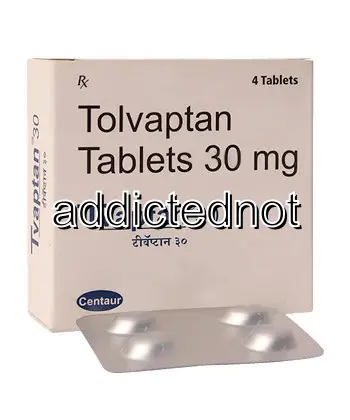| Package | Dosage | Price | Price per Dose | |
|---|---|---|---|---|
| Dosage: 15mg | ||||
| 180 pill | 15mg | €1,529.21 | €8.50 | |
| 120 pill | 15mg | €1,036.75 | €8.64 | |
| 90 pill | 15mg | €790.52 | €8.78 | |
| 60 pill | 15mg | €535.65 | €8.93 | |
| 30 pill | 15mg | €272.14 | €9.07 | |
| 20 pill | 15mg | €184.30 | €9.22 | |
| 10 pill | 15mg | €93.58 | €9.36 | |
| Dosage: 30mg | ||||
| 120 pill | 30mg | €1,350.65 | €11.26 | |
| 90 pill | 30mg | €1,030.99 | €11.46 | |
| 60 pill | 30mg | €699.80 | €11.66 | |
| 30 pill | 30mg | €352.77 | €11.76 | |
| 20 pill | 30mg | €237.58 | €11.88 | |
| 10 pill | 30mg | €119.50 | €11.95 | |

Tolvaptan Description
Introduction to Tolvaptan
Tolvaptan is a medication primarily used to treat certain medical conditions related to water balance and fluid retention. It belongs to a class of drugs known as vasopressin receptor antagonists. This medication works by blocking the action of vasopressin, a hormone that controls the kidneys' ability to conserve water. By inhibiting vasopressin, Tolvaptan promotes the excretion of free water without losing electrolytes, helping to manage conditions like hyponatremia.
Uses and Medical Benefits
The primary indication for Tolvaptan is the treatment of euvolemic hyponatremia, especially in cases caused by the syndrome of inappropriate antidiuretic hormone secretion (SIADH). It is also used in managing autosomal dominant polycystic kidney disease (ADPKD). In ADPKD patients, Tolvaptan helps slow the growth of kidney cysts, preserving kidney function over time. Its ability to regulate water retention makes it a valuable medication for patients with fluid overload conditions, offering significant improvements in symptoms and quality of life.
How the Medication Works
Tolvaptan works by selectively blocking V2 vasopressin receptors found in the kidneys. This blockade prevents vasopressin from binding to these receptors, thereby reducing water reabsorption in the collecting ducts. As a result, more water is expelled through urine, which helps to correct low sodium levels in the blood. This mechanism distinguishes Tolvaptan from diuretics, which promote salt and water loss. It provides a targeted approach to managing water imbalance without causing excessive loss of electrolytes.
Dosage and Administration
The dosage of Tolvaptan varies depending on the condition being treated and the patient’s response. It is usually administered orally once or twice daily. Doctors typically start with a low dose to assess tolerance and gradually increase if necessary. Close monitoring of blood sodium levels is crucial during treatment to avoid complications like rapid correction of hyponatremia. Patients should follow their healthcare provider’s instructions carefully and report any adverse effects immediately.
Possible Side Effects
While Tolvaptan is generally well tolerated, some patients may experience side effects. Common adverse reactions include thirst, dry mouth, increased urination, and weakness. Less frequently, some may encounter more serious issues such as dehydration, liver injury, or changes in liver function tests. Liver toxicity is a notable concern, and regular liver function monitoring is recommended during therapy. Patients should seek medical advice if they experience symptoms like jaundice, severe fatigue, or abdominal pain.
Precautions and Considerations
Before starting Tolvaptan, patients should disclose their complete medical history to the healthcare provider. Caution is advised in individuals with liver disease, as the medication can affect liver function. It is important to monitor sodium and liver function regularly during treatment. Tolvaptan should be used with care in elderly patients or those with cardiovascular conditions. Pregnant and breastfeeding women should discuss potential risks with their doctor, as safety data in these populations are limited.
Conclusion
Tolvaptan offers a targeted approach to managing disorders related to water retention and hyponatremia. Its ability to promote free water excretion without causing significant electrolyte loss makes it effective in specific clinical scenarios. As with any medication, careful monitoring and adherence to medical guidance are essential to maximize benefits and minimize risks. Patients considering Tolvaptan should consult with a healthcare professional to determine if it is appropriate for their condition and to ensure safe usage.
